Green Roofs and Greenpass
Abstract
:1. Introduction
2. Materials and Methods
2.1. GREENPASS® Method
2.1.1. Toolbox
- Assessment for preliminary design phase (01): low level of planning detail, results (five key performance indicators (KPIs)) produced based on machine learning engine, time of service: 3 h per project design;
- Pre-certification for concept design phase (02): low level of planning detail, results (12 KPIs, 3 urban challenges) produced based on simplified simulation and assessment process, time of service from 2 days per project design;
- Certification for detailed design phase (03): high level of planning detail, iterative optimization based on complex simulation and assessment processes (27 KPIs, six urban challenges), time of service depending on project progress.
2.1.2. GREENPASS® Pre-Certification
- TLS—Thermal Load Score: temperature difference of in and out streaming air body;
- TCS—Thermal Comfort Score: numerical rating of thermal comfort areas;
- TSS—Thermal Storage Score: heat energy storage in materials within project area;
- ROF—Run-Off Score: proportion of retained rainwater to project area;
- CSS—Carbon Sequestration Score: storage of CO2 by green infrastructure in project area;
- PET—Physiological Equivalent Temperature: maps of PET at 15:00, 22:00 and 04:00;
- RAD—Radiation: sum of shortwave radiation coming into project area;
- ALB—Albedo: average albedo of the project area;
- EVA—Evapotranspiration: evaporation of soil and transpiration of plants;
- SAF—Shading Area Factor: ratio of shaded area;
- LA—Leaf Area: sum of total leaf area;
- WF—Wind Flow Map: direction and velocity of wind at 15:00.
- Variant Status Quo (SQ): existing building and material situation;
- Variant A: extensive green roof design;
- Variant B: extensive green roof design.
- AT—air temperature at 15:00 and 04:00 at ground (1.5 m) and roof level (2.7 m);
- PET—at 15:00 and 04:00 at ground (1.5 m) and roof level (2.7 m);
- IAT—Indoor Air Temperature: hourly day profile;
- EFB—Energy Flux of Building: hourly day profile;
- TLS—Thermal Load Score: temperature difference of in- and out-streaming air bodies;
- TCS—Thermal Comfort Score: numerical rating of thermal comforts;
- TSS—Thermal Storage Score: heat energy storage in project area;
- ROF—Run-Off Score: proportion of retained rainwater to project area;
- CSS—Carbon Sequestration Score: storage of CO2 by green infrastructure in project area.
2.1.3. GREENPASS® Editor
2.2. Case Study—Elief Playhouse Antwerp
- Variant A;
- Variant B.
3. Results—Case Study Elief Playhouse Antwerp
4. Results and Discussion
4.1. Urban Challenge of Climate: Thermal Comfort on Pedestrian Level
4.2. Urban Challenge of Water: Runoff
4.3. Urban Challenge of Energy: Indoor Air Temperature and Energy Flux
4.4. GREENPASS® Method
5. Green Roofs and Greenpass—Conclusions
Author Contributions
Funding
Acknowledgments
Conflicts of Interest
References
- United Nations. Transforming Our World: The 2030 Agenda for Sustainable Development; A/RES/70/1; United Nations: New York, NY, USA, 2015. [Google Scholar]
- Intergovernmental Panel on Climate Change. Global Warming of 1.5 °C; An IPCC Special Report on the Impacts of Global Warming of 1.5 °C above Pre-Industrial Levels and Related Global Greenhouse Gas Emission Pathways, in the Context of Strengthening the Global Response to the Threat of Climate Change, Sustainable Development, and Efforts to Eradicate Poverty; IPCC: Geneva, Switzerland, October 2018; ISBN 978-92-9169-151-7. [Google Scholar]
- Noble, I.R.; Huq, S.; Anokhin, Y.A.; Carmin, J.; Goudou, D.; Lansigan, F.P.; Osman-Elasha, B.; Villamizar, A. Adaptation needs and options. In Climate Change 2014: Impacts, Adaptation, and Vulnerability. Part A: Global and Sectoral Aspects; Contribution of Working Group II to the Fifth Assessment Report of the Intergovernmental Panel on Climate Change; Field, C.B., Barros, V.R., Dokken, D.J., Mach, K.J., Mastrandrea, M.D., Bilir, T.E., Chatterjee, M., Ebi, K.L., Estrada, Y.O., Genova, R.C., et al., Eds.; Cambridge University Press: Cambridge, UK; New York, NY, USA, 2014; pp. 833–868. [Google Scholar]
- Revi, A.; Satterthwaite, D.E.; Aragón-Durand, F.; Corfee-Morlot, J.; Kiunsi, R.B.R.; Pelling, M.; Roberts, D.C.; Solecki, W. Urban areas. In Climate Change 2014: Impacts, Adaptation, and Vulnerability. Part A: Global and Sectoral Aspects; Contribution of Working Group II to the Fifth Assessment Report of the Intergovernmental Panel on Climate Change; Field, C.B., Barros, V.R., Dokken, D.J., Mach, K.J., Mastrandrea, M.D., Bilir, T.E., Chatterjee, M., Ebi, K.L., Estrada, Y.O., Genova, R.C., et al., Eds.; Cambridge University Press: Cambridge, UK; New York, NY, USA, 2014; pp. 535–612. [Google Scholar]
- Bastin, J.-F.; Clark, E.; Elliott, T.; Hart, S.; van den Hoogen, J.; Hordijk, I.; Ma, H.; Majumder, S.; Manoli, G.; Maschler, J.; et al. Understanding Climate Change from a Global Analysis of City Analogues; Crowther Lab, Department of Environmental Systems Science, Institute of Integrative Biology, ETH Zürich: Zürich, Switzerland; Plant Ecology, Department of Environmental Systems Science, Institute of Integrative Biology, ETH Zürich: Zürich, Switzerland; Department of Civil, Environmental and Geomatic Engineering, Institute of Environmental Engineering, ETH Zürich: Zürich, Switzerland, 2019. [Google Scholar]
- United Nations. World Urbanization Prospects: The 2018 Revision; Department of Economic and Social Affairs, Population Division: New York, NY, USA, 2018. [Google Scholar]
- European Union. Towards an EU Research and Innovation Policy Agenda for Nature-Based Solutions & Re-Naturing Cities; Final Report of the Horizon 2020 Expert Group on ‘Nature-Based Solutions and Re-Naturing, Cities’; Directorate-General for Research and Innovation; Climate Action, Environment, Resource Efficiency and Raw Materials EN, (Full Version); Publications Office of the European Union: Luxembourg, 2015; ISBN 978-92-79-46051-7. [Google Scholar]
- The European Parliament and the Council of the European Union. Directive 2010/31/EU of the European Parliament and of the councial of 19 May 2010 on the energy performance of buildings. Offi. J. Eur. Union 2010, L 153, 13–35.
- Neri, M.; Lezzi, A.M.; Beretta, G.P.; Pilotelli, M. Energy- and Exergy-Based Analysis for Reducing Energy Demand in Heat Processes for Aluminum Casting. J. Energy Resour. Technol. Trans. ASME 2019, 141, 104501. [Google Scholar] [CrossRef]
- Young, B.A.; Gabriel, F.; Zhenyu, S.; Thiele, A.M.; Wei, Z.; Narayanan, N.; Sant, G.; Pilon, D. Early-age temperature evolutions in concrete pavements containing microencapsulated phase change materials. Constr. Build. Mater. 2017, 4, 150. [Google Scholar] [CrossRef]
- Bundesministerium für Umwelt, Naturschutz, Bau und Reaktorsicherheit (BMUB) Referat Öffentlichkeitsarbeit. Weißbuch Stadtgrün, Grün in der Stadt—Für eine lebenswerte Zukunft; Brandenburgische Universitätsdruckerei und Verlagsgesellschaft Potsdam mbH, Bundesministerium für Umwelt, Naturschutz, Bau und Reaktorsicherheit (BMUB): Berlin, Germany, 2007. [Google Scholar]
- United Nations Environment Programme. Ecosystem-Based Adaptation. Available online: https://www.unenvironment.org/explore-topics/climate-change/what-we-do/adaptation-and-resilience/ecosystem-based-adaptation (accessed on 25 November 2018).
- EEA. Urban Adaptation to Climate Change in Europe: Challenges and Opportunities for Cities Together with Supportive National and European Policies; EEA Report, No. 2/2012; European Environment Agency (EEA): Copenhagen, Denmark, 2012; p. 143. [Google Scholar]
- Rizvi, A.R.; Baig, S.; Verdone, M. Ecosystems Based Adaptation: Knowledge Gaps in Making an Economic Case for Investing in Nature Based Solutions for Climate Change; IUCN: Gland, Switzerland, 2015; p. 48. [Google Scholar]
- European Commission. Urban Agenda for the EU ‘Pact of Amsterdam’; European Commission: Amsterdam, The Netherlands, 2016. [Google Scholar]
- European Commission. Communication from the Commission to the European Parliament, the Council, the European Economic and Social Committee and the Committee of the Regions; Green Infrastructure (GI)—Enhancing Europe’s Natural Capital {SWD(2013) 155 Final}; European Commission: Brussels, Belgium, 2013. [Google Scholar]
- Magistrat der Stadt Wien, Wiener Umweltschutzabteilung—Magistratsabteilung 22. Urban Heat Islands Strategieplan Wien; Brandenburg, C., Damyanovic, D., Reinwald, F., Allex, B., Gantner, B., Czachs, C., Eds.; Jürgen Preiss, Christian Härtel Wiener Umweltschutzabteilung—Magistratsabteilung 22: Projektkoordination, Magistrat der Stadt Wien, Wiener Umweltschutzabteilung—Magistratsabteilung 22: Vienna, Austria, 2015. [Google Scholar]
- Gutiérrez, A.I.; Ramos-Mejía, M. Function-Based and Multi-Scale Approach to Green Roof Guidelines for Urban Sustainability Transitions: The Case of Bogota. Buildings 2019, 9, 151. [Google Scholar] [CrossRef]
- Forschungsgesellschaft Landschaftsentwicklung Landschaftsbau e. V. Dachbegrünungsrichtlinien—Richtlinien für Planung, Bau und Instandhaltung von Dachbegrünungen; Forschungsgesellschaft Landschaftsentwicklung Landschaftsbau e.V.—FLL: Bonn, Germany, 2018. [Google Scholar]
- Austrian Standards Institut. ÖNORM L 1131 Gartengestaltung und Landschaftsbau—Begrünung von Dächern und Decken auf Bauwerken—Anforderungen an Planung, Ausführung und Erhaltung; Austrian Standards Institute/Österreichisches Normungsinstitut (ON): Wien, Austria, 2010. [Google Scholar]
- Pitha, U.; Scharf, B.; Enzi, V. Comparison of laboratory and in-field water storage properties of different green roofs and gravel roof. In Proceedings of the World Green Roof Congress, Urban Grey to Urban Green, Copenhagen, Denmark, 18–21 September 2012. [Google Scholar]
- Hu, S.; Lijiao, L.; Cao, J.; Chen, N.; Wang, Z. Water Resilience by Centipedegrass Green Roof: A Case Study. Buildings 2019, 9, 141. [Google Scholar] [CrossRef]
- Chan, F.K.S.; Griffiths, J.A.; Higgitt, D.; Xu, S.; Zhu, F.; Tang, Y.T.; Xu, Y.; Thorne, C.R. “Sponge City” in China—A breakthrough of planning and flood risk management in the urban context. Land Use Policy 2018, 76, 772–778. [Google Scholar] [CrossRef]
- Shafique, M.; Kim, R.; Rafiq, M. Green roof benefits, opportunities and challenges—A review. Renew. Sustain. Energy Rev. 2018, 90, 757–773. [Google Scholar] [CrossRef]
- Oke, T.R. Boundary Layer Climates; Routledge: Vancouver, BC, Canada, 1988; ISBN 0-203-40721-0. [Google Scholar]
- Andenaes, E.; Kvande, T.; Muthana, T.M.; Lohne, J. Performance of Blue-Green Roofs in Cold Climates: A Scoping Review. Buildings 2018, 8, 55. [Google Scholar] [CrossRef]
- Peng, L.L.; Jim, C.Y. Green-roof effects on neighborhood microclimate and human thermal sensation. Energies 2013, 6, 598–618. [Google Scholar] [CrossRef]
- Zhang, G.; He, B.-J.; Zhu, Z.; Dewancker, B.J. Impact of Morphological Characteristics of Green Roofs on Pedestrian Cooling in Subtropical Climates. Int. J. Environ. Res. Public Health 2019, 16, 179. [Google Scholar] [CrossRef] [PubMed]
- Köhler, M.; Kaiser, D. Evidence of the Climate Mitigation Effect of Green Roofs—A 20 Year Weather Study on an Extensive Green Roof (EGR) in Northeast Germany. Buildings 2019, 9, 157. [Google Scholar] [CrossRef]
- Ng, E.; Chen, L.; Wang, Y.; Wang, Y.C. A study on the cooling effects of greening in a high-density city: An experience from Hong Kong. Build. Environ. 2012, 47, 256–271. [Google Scholar] [CrossRef]
- Rosenzweig, C.; Gaffin, S.; Parshall, L. Green Roofs in the New York Metropolitan Region; Research Report; Columbia University Center for Climate Systems Research NASA Goddard Institute for Space Studies: New York, NY, USA, 2006. [Google Scholar]
- Morakinyo, T.E.; Dahanayake, K.K.C.; Ng, E.; Chow, C.L. Temperature and cooling demand reduction by green-roof types in different climates and urban densities: A co-simulation parametric study. Energy Build. 2017, 145, 226–237. [Google Scholar] [CrossRef]
- Scharf, B.; Pitha, U.; Trimmel, H. Thermal performance of green roofs. In Proceedings of the World Green Roof Congress, Urban Grey to Urban Green, Copenhagen, Denmark, 18–21 September 2012. [Google Scholar]
- Schmidt, M. Pflanzlicher Sonnenschutz—Gebäudebegrünung, Energieeinsparung und Klimaschutz im Doppelpack; Landschaftsarchitekten 02/2017; Patzer Verlag GmbH & Co KG: Berlin/Hannover, Germany, 2017. [Google Scholar]
- Mattuschka, F. Untersuchung gebäudeintegrierter Begrünungen, sowie deren bauphysikalische Wirkungen im Zuge des PROGREENcity-Projekts am Versuchsgebäude in Aranjuez (Spanien). Master’s Thesis, Universität für Bodenkultur Wien, Department für Bautechnik und Naturgefahren, Institut für Ingenieurbiologie und Landschaftsbau, Vienna, Austria, 2019. [Google Scholar]
- Smith, K.R.; Roebber, P.J. Green Roof Mitigation Potential for a Proxy Future Climate Scenario in Chicago, Illinois; Atmospheric Science Group, Department of Mathematical Sciences, University of Wisconsin: Milwaukee, WI, USA, 2010. [Google Scholar]
- Köhler, M.; Schmidt, M.; Laar, M. Green Roofs as a contribution to reduce urban heat islands. In Proceedings of the RIO 3—World Climate & Energy Event, Rio de Janeiro, Brazil, 1–5 December 2003. [Google Scholar]
- Santamouris, M. Cooling the cities—A review of reflective and green roof mitigation technologies to fight heat island and improve comfort in urban environments. Sol. Energy 2014, 103, 682–703. [Google Scholar] [CrossRef]
- Lotte, F.M.F.; Marina, B.J. Benefits of green roofs: A systematic review of the evidence for three ecosystem services. Urban For. Urban Green. 2017, 28, 167–176. [Google Scholar] [CrossRef]
- Scharf, B.; Zluwa, I. Case study investigation of the building physical properties of seven different green roof systems. Energy Build. 2017, 151, 564–573. [Google Scholar] [CrossRef]
- Kraus, F.; Scharf, B. Management of Urban Climate Adaptation with NBS and GREENPASS®; EGU: Vienna, Austria, 2019. [Google Scholar]
- James, E.; Rajagopalan, P. The effect of green roofs on pedestrian level air temperature. In Proceedings of the BS2015: 14th Conference of International Building Performance Simulation Association, Hyderabad, India, 7–9 December 2015. [Google Scholar]
- NYC Mayor’s Office of Sustainability. NYC Coolroofs. Available online: https://coolroofs.org/documents/NYC_CoolRoofs_6-14-17_Presentation.pdf (accessed on 10 June 2019).
- Akbari, H.; Matthews, H.D.; Seto, D. The long-term effect of increasing the albedo of urban areas. IOP Publ. Environ. Res. Lett. 2012, 7, 024004. [Google Scholar] [CrossRef]
- Scharf, B. Coole Städte Planen—Mit der “Greenpass-Methode”; Neue Landschaft 01/2018; Patzer Verlag: Berlin/Hannover, Germany, 2018. [Google Scholar]
- Bruse, M. ENVI-Met Documentation; Universität Mainz: Mainz, Germany, 2004. [Google Scholar]
- Simon, H. Modeling Urban Microclimate—Development, Implementation and Evaluation of New and Improved Calculation Methods for the Urban Microclimate Model ENVI-Met; Universität Mainz: Mainz, Germany, 2016. [Google Scholar]
- ENVI-met (nA). Evaluations & Reviews. Available online: http://www.envi-met.info/doku.php?id=kb:review (accessed on 10 June 2019).
- Green4cities. Development of an Evaluation Tool for Green Infrastructure and Their Positive Effects Derived for Cities Worldwide; ERA-SME R&D Project; Green4Cities: Vienna, Austria, 2012–2015. [Google Scholar]
- Kraus, F. The GREENPASS® Methodology; Pan European Network—Government 23 Publication: UK, 2017. [Google Scholar]
- Elagiry, M.; Kraus, F.; Scharf, B.; Costa, A.; De Lotto, R. Nature 4 Cities: Nature-Based Solutions and Climate Resilient Urban Planning and Decision Making with GREENPASS® Tool—A Case Study in Segrate/Milano/IT; Building Simulations: Rome, Italy, 2017. [Google Scholar]
- Greenpass Modelling (Ed.) GP.Me; R&D Project Vienna Business Agency: Vienna, Austria, 2015–2016. [Google Scholar]
- Stadslab2050 (nA). Wat Is Stadslabor2050? Available online: https://stadslab2050.be/het-lerend-lab/wat-doet-een-stadslab/wat-stadslab2050 (accessed on 10 June 2019).
- rp5.ru (nA). Weather Data Antwerpen, Deurne. Available online: https://rp5.ru/Wetterarchiv_in_Antwerpen,_Deurne_(Flughafen),_METAR (accessed on 10 June 2019).
- windfinder.com (nA). Wind statistics Antwerpen Luchthaven. Available online: https://www.windfinder.com/windstatistics/antwerpen (accessed on 10 June 2019).
- Berardi, U. The outdoor microclimate benefits and energy saving resulting from green roofs retrofits. Energy Build. 2016, 121, 217–229. [Google Scholar] [CrossRef]
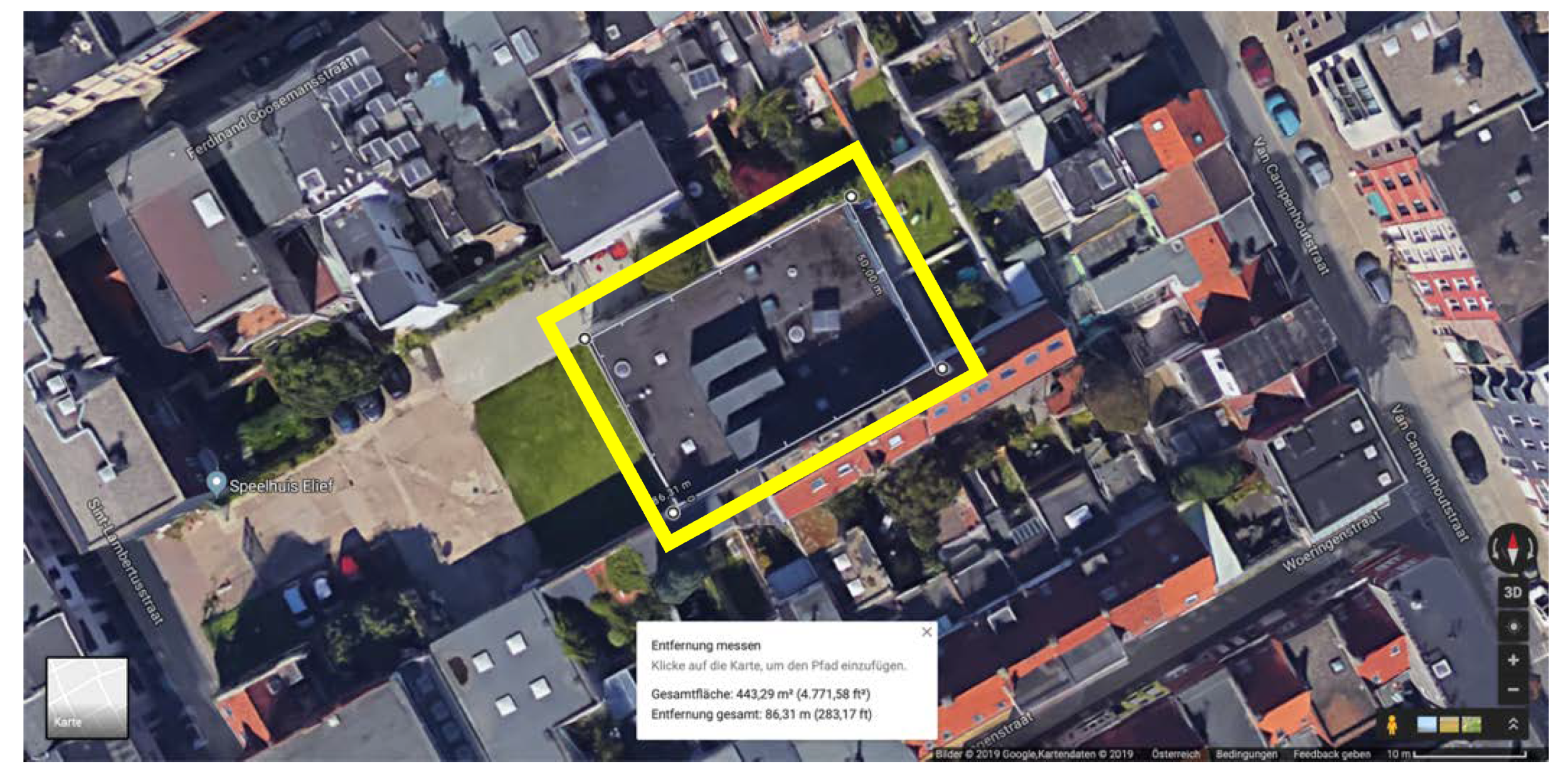
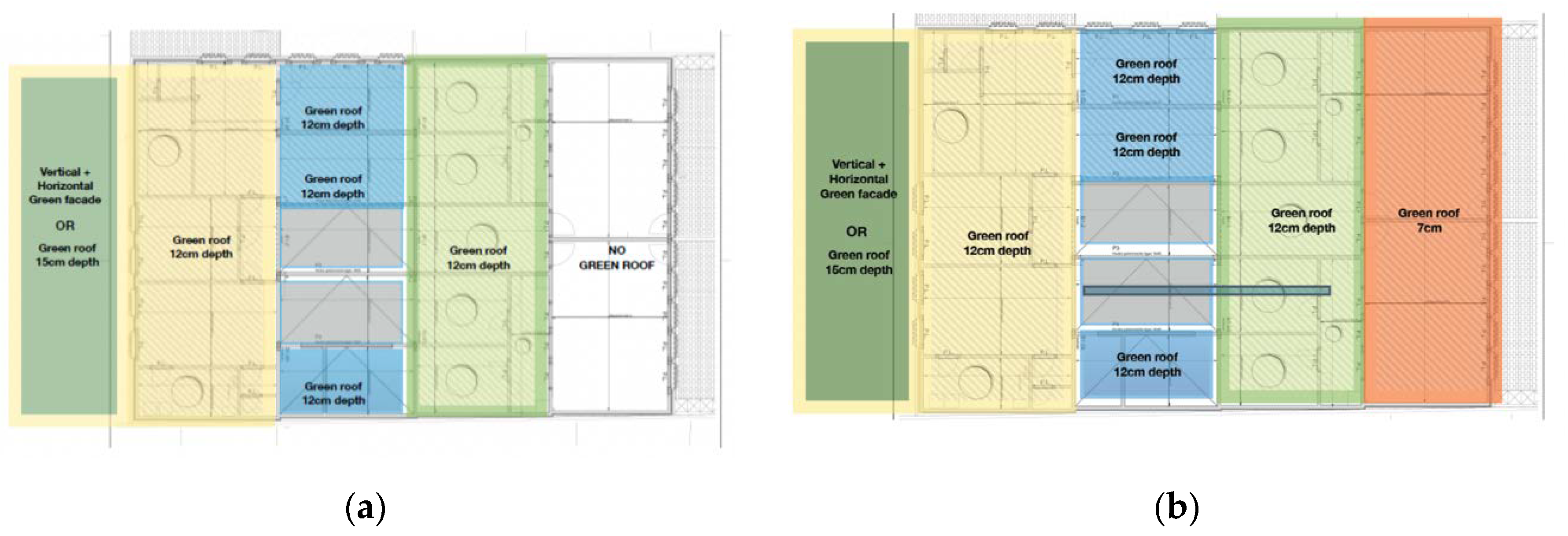

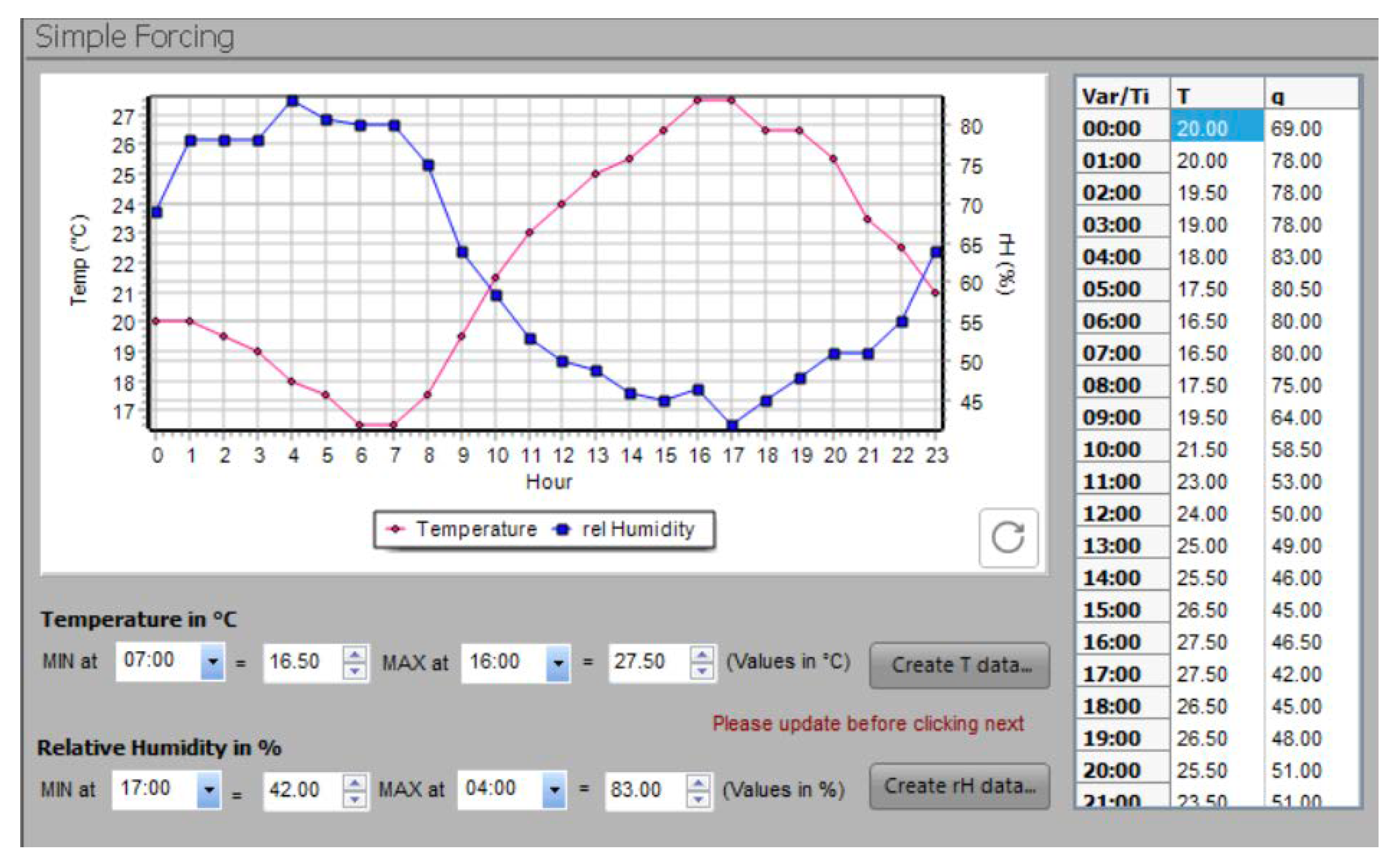
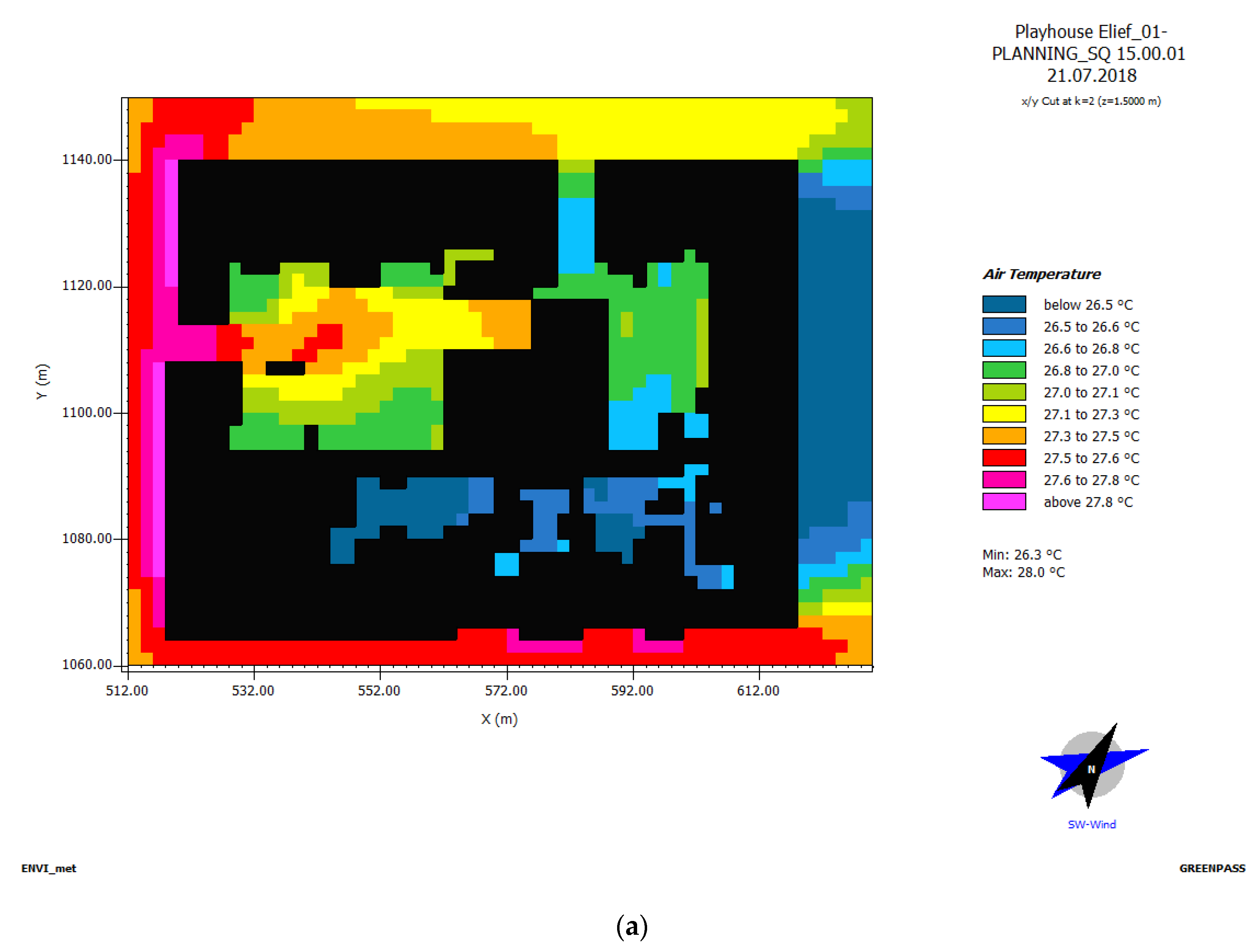
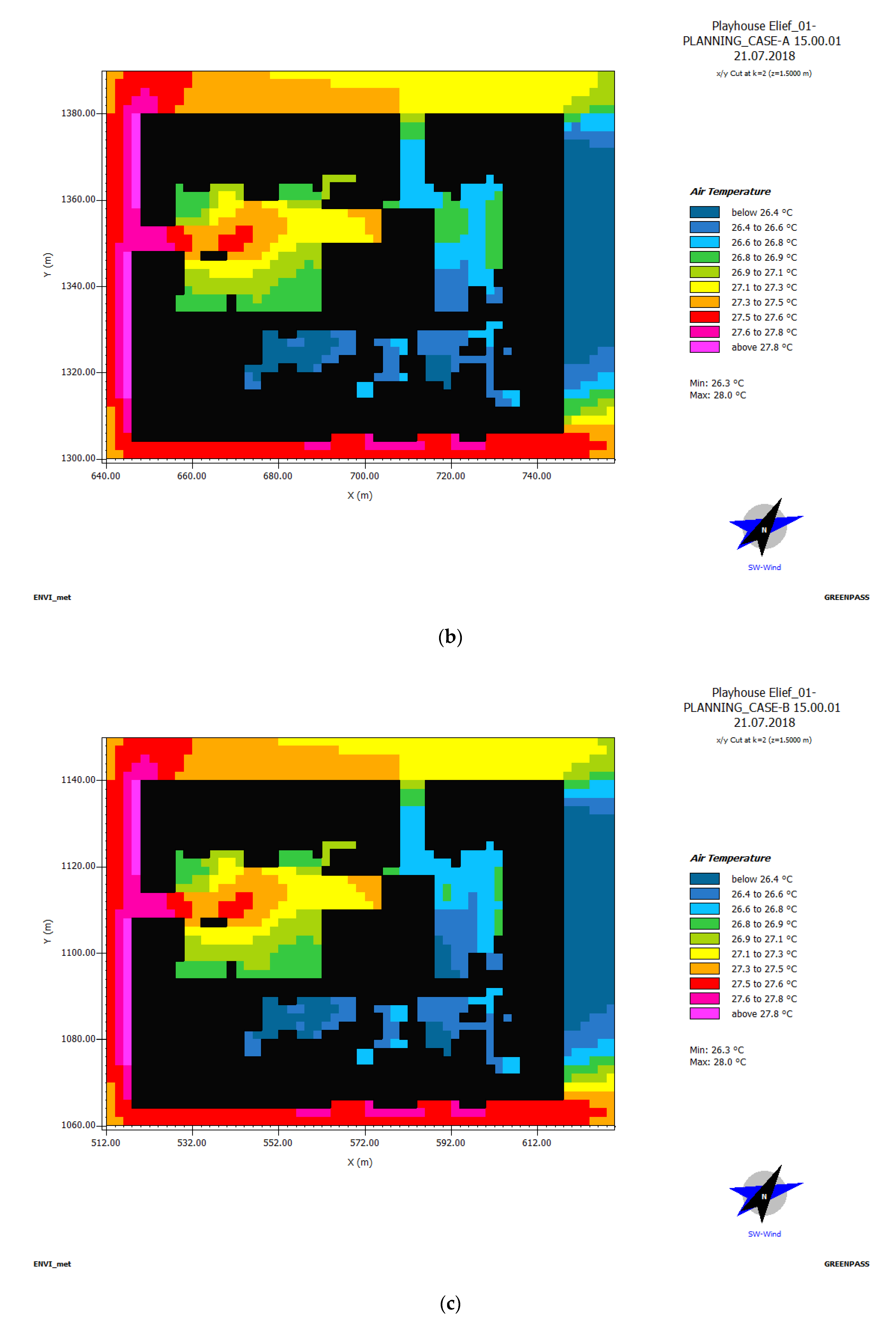
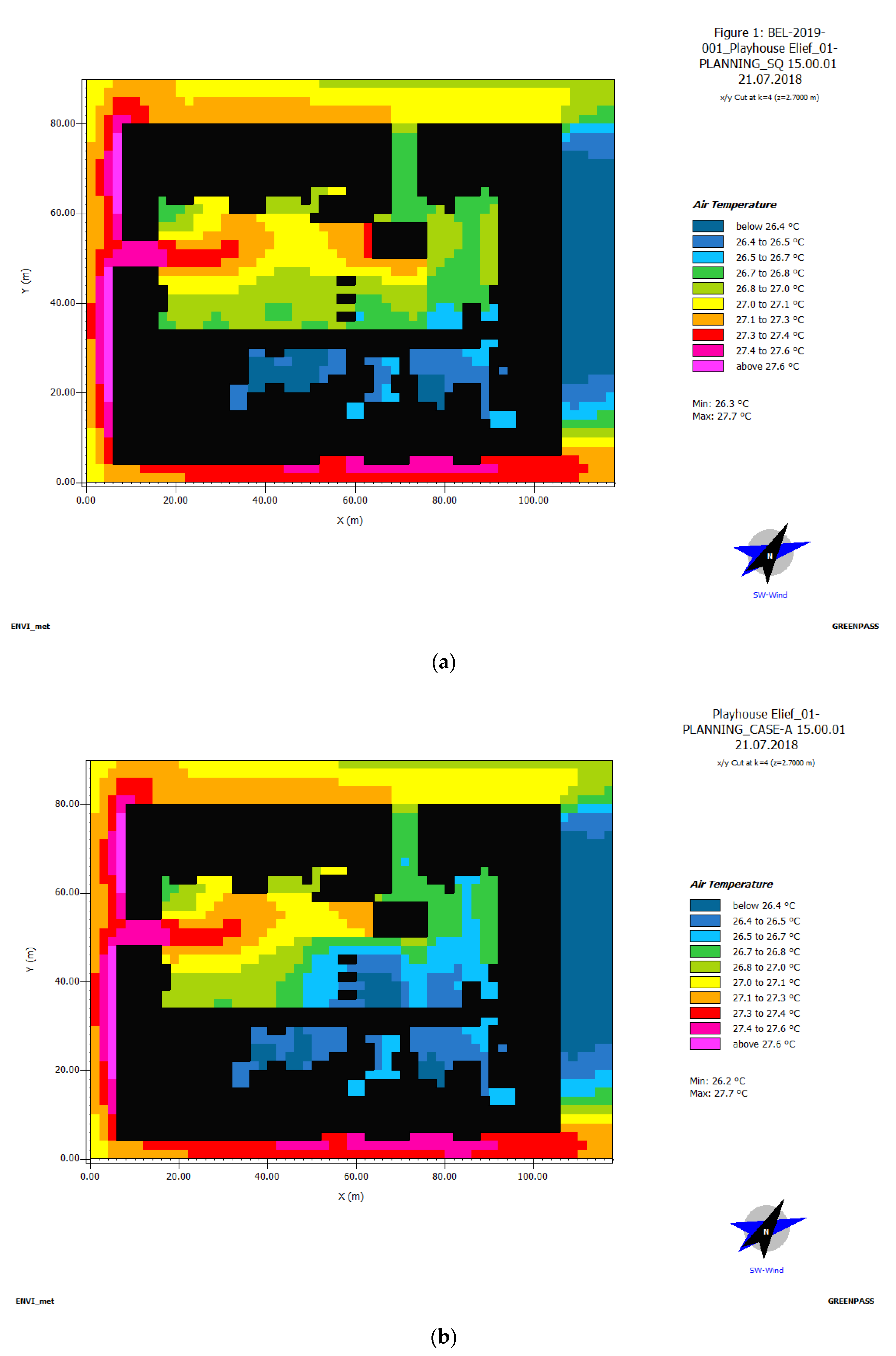
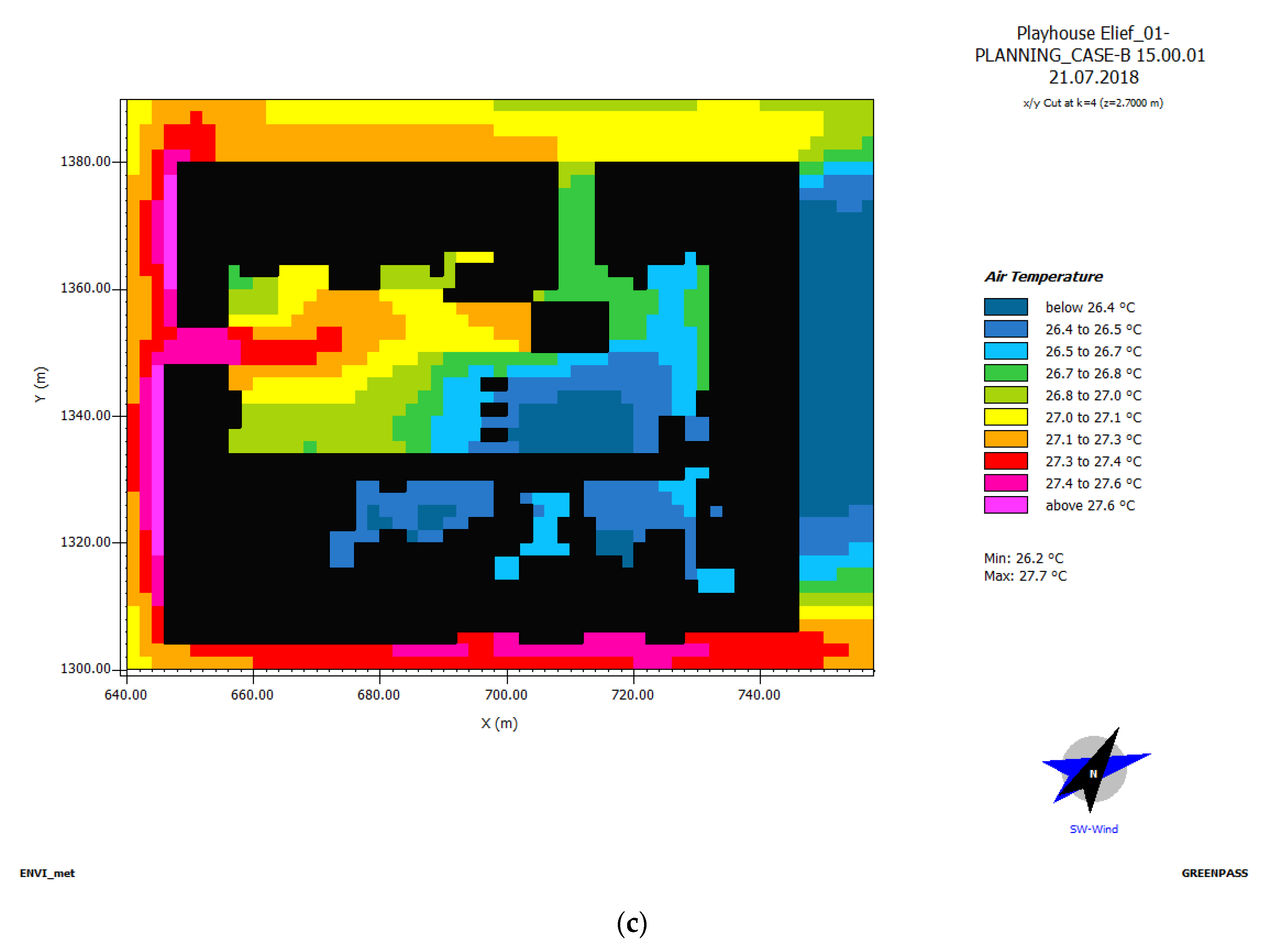
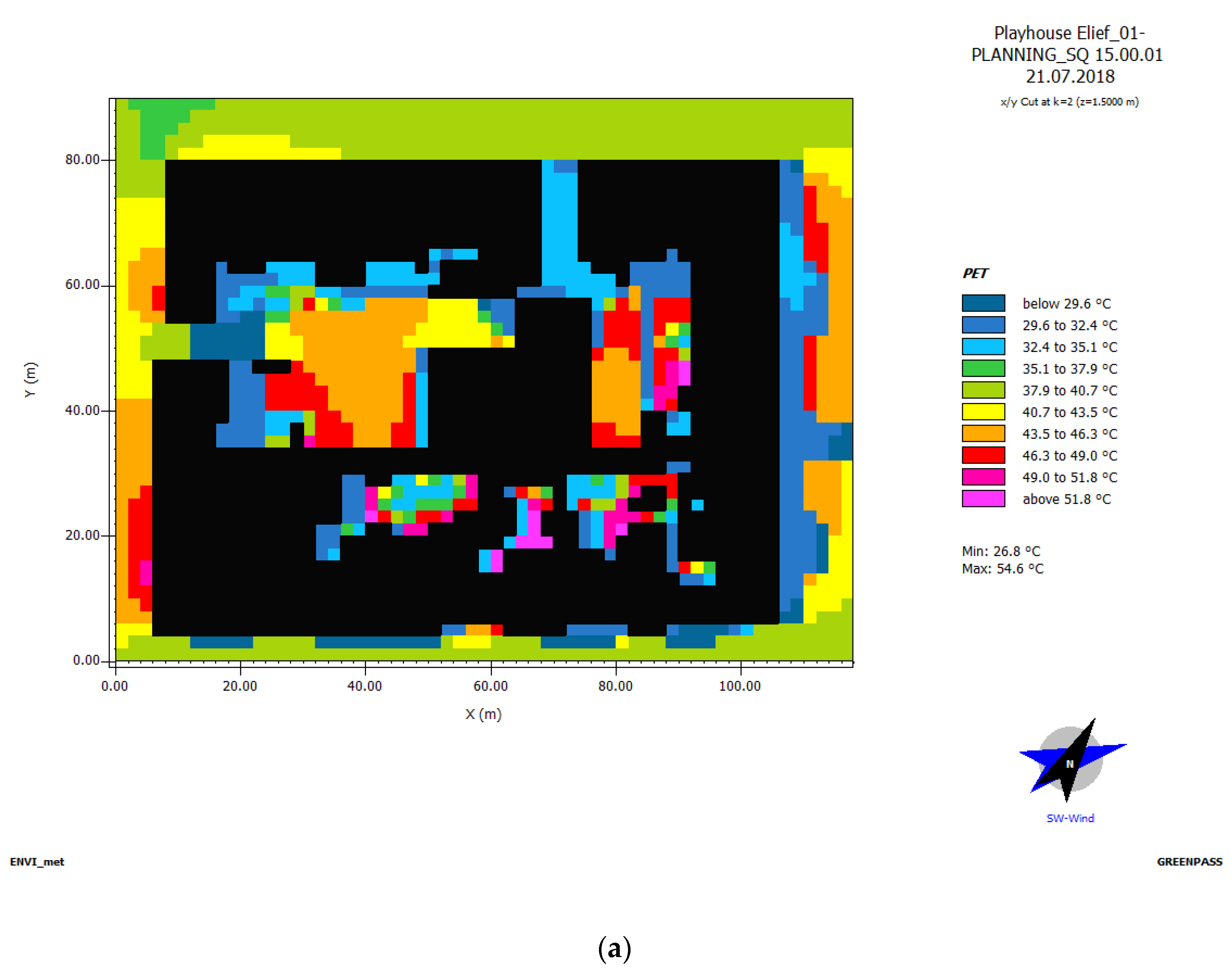
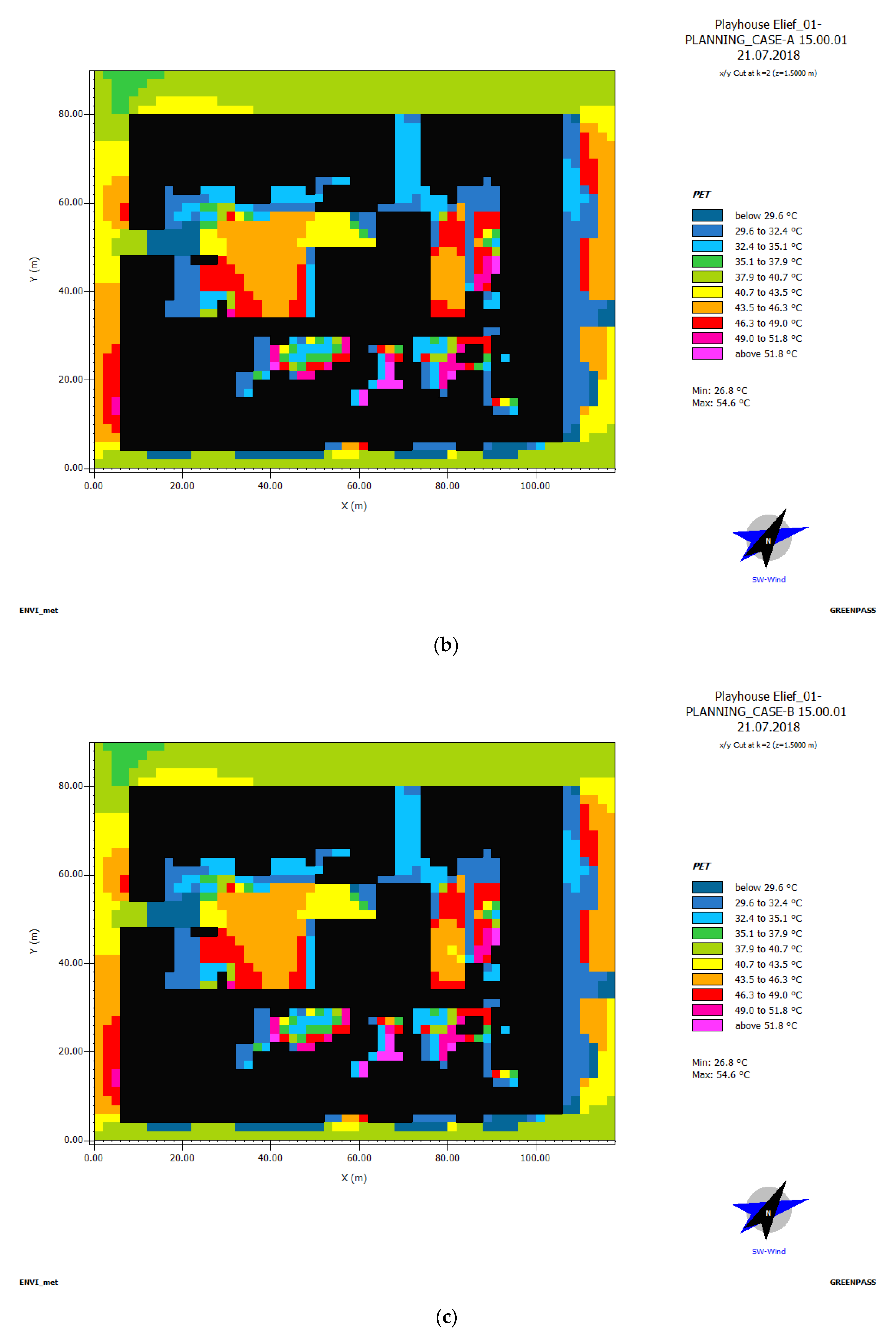



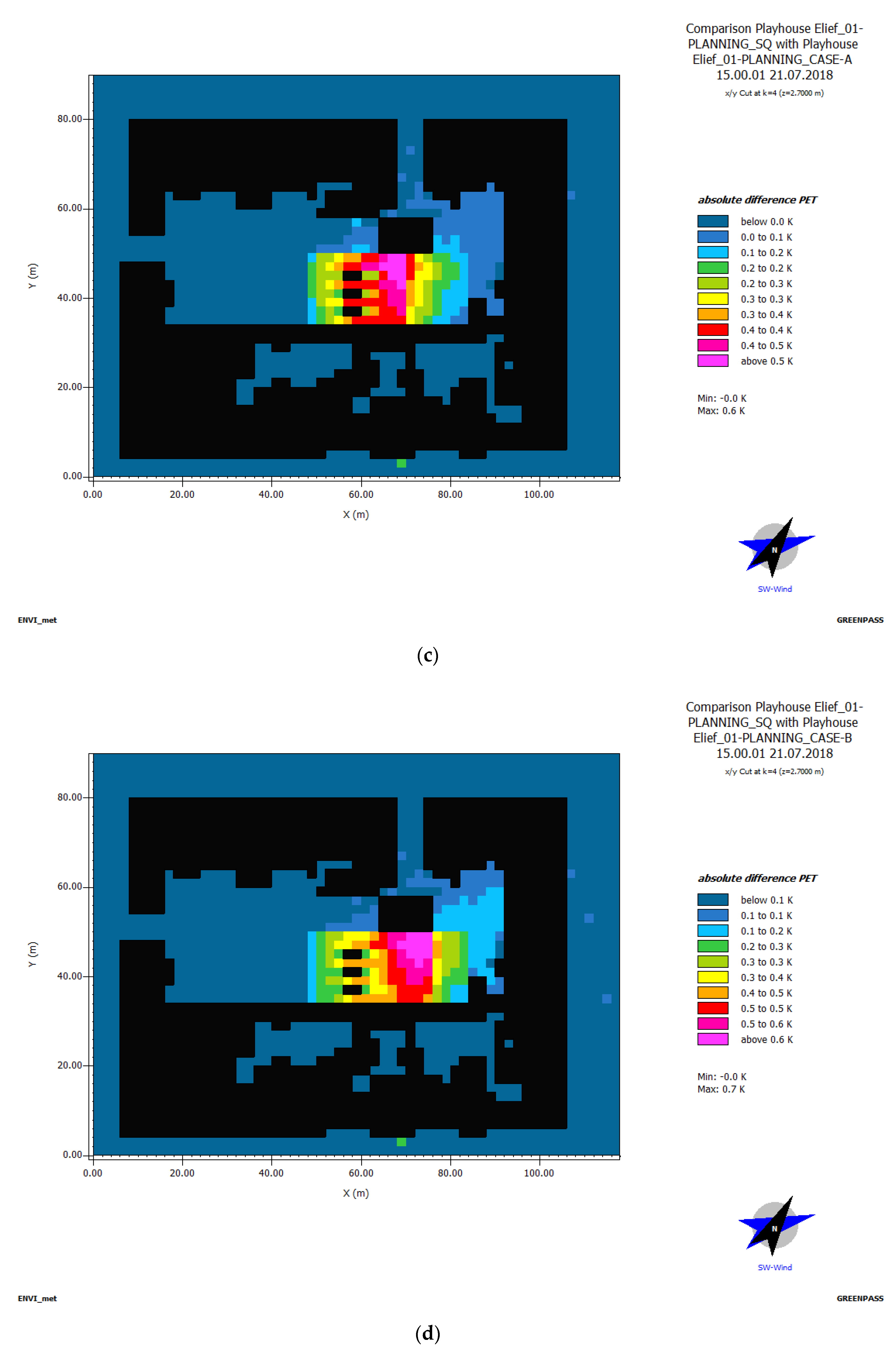
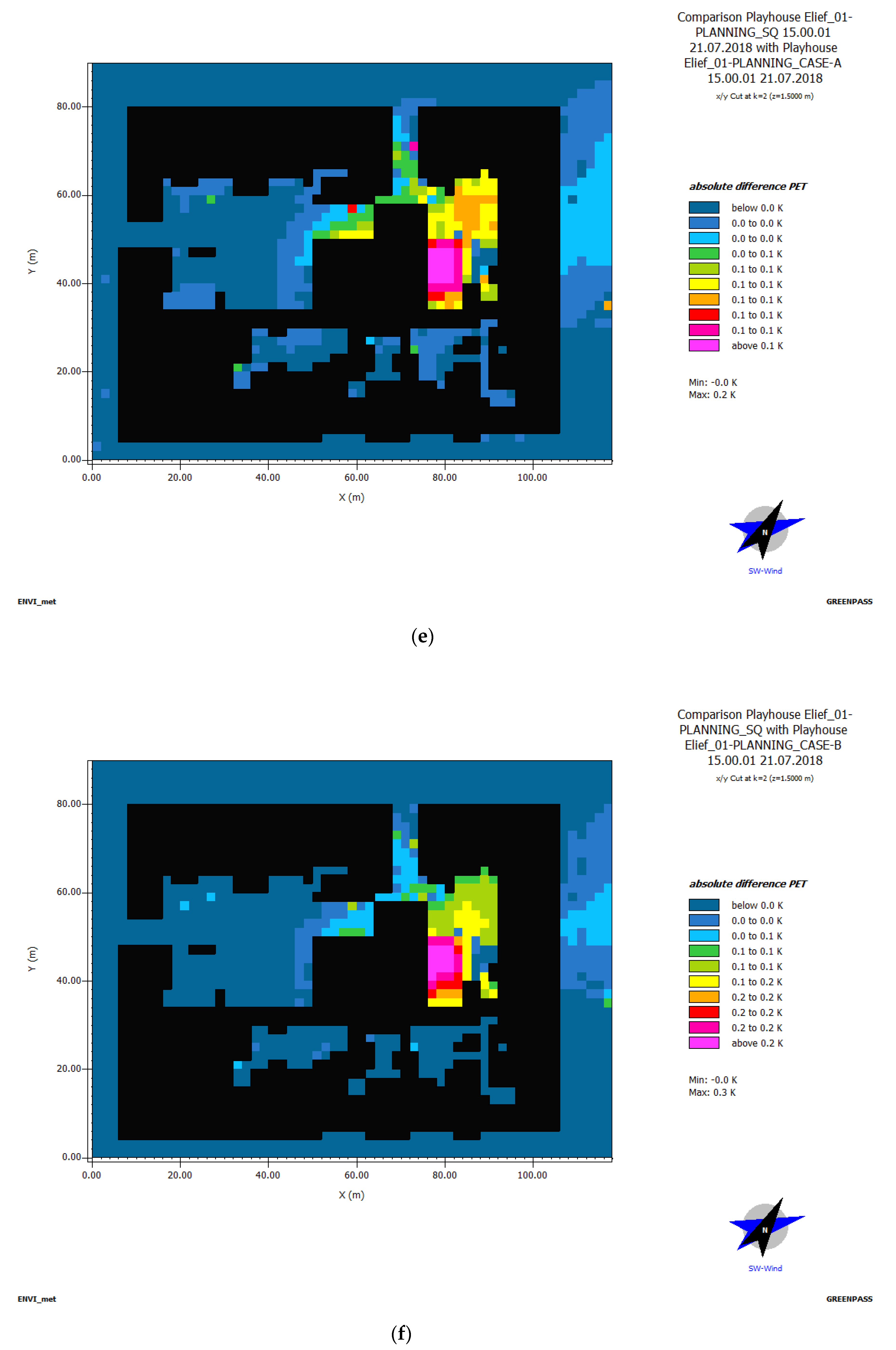
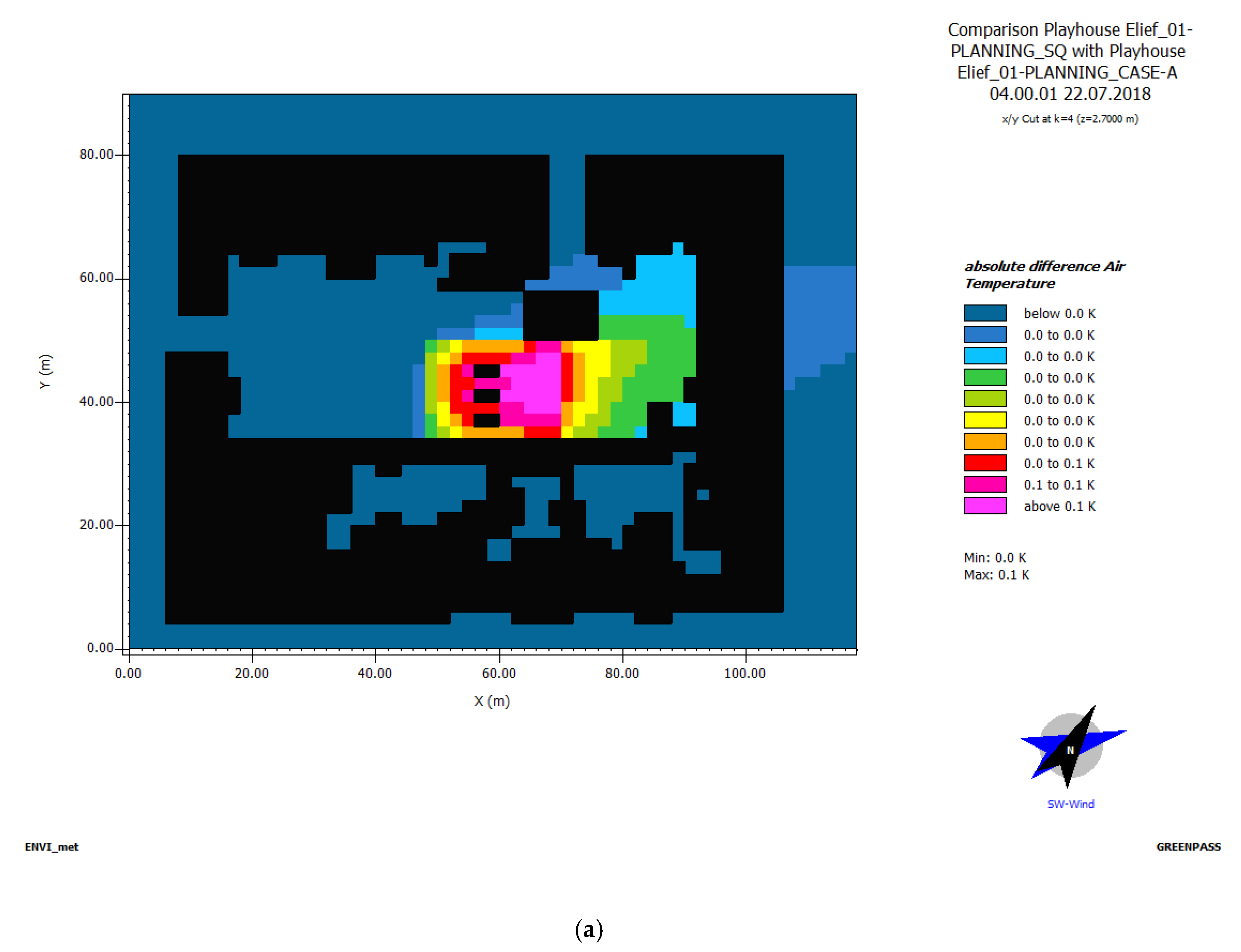
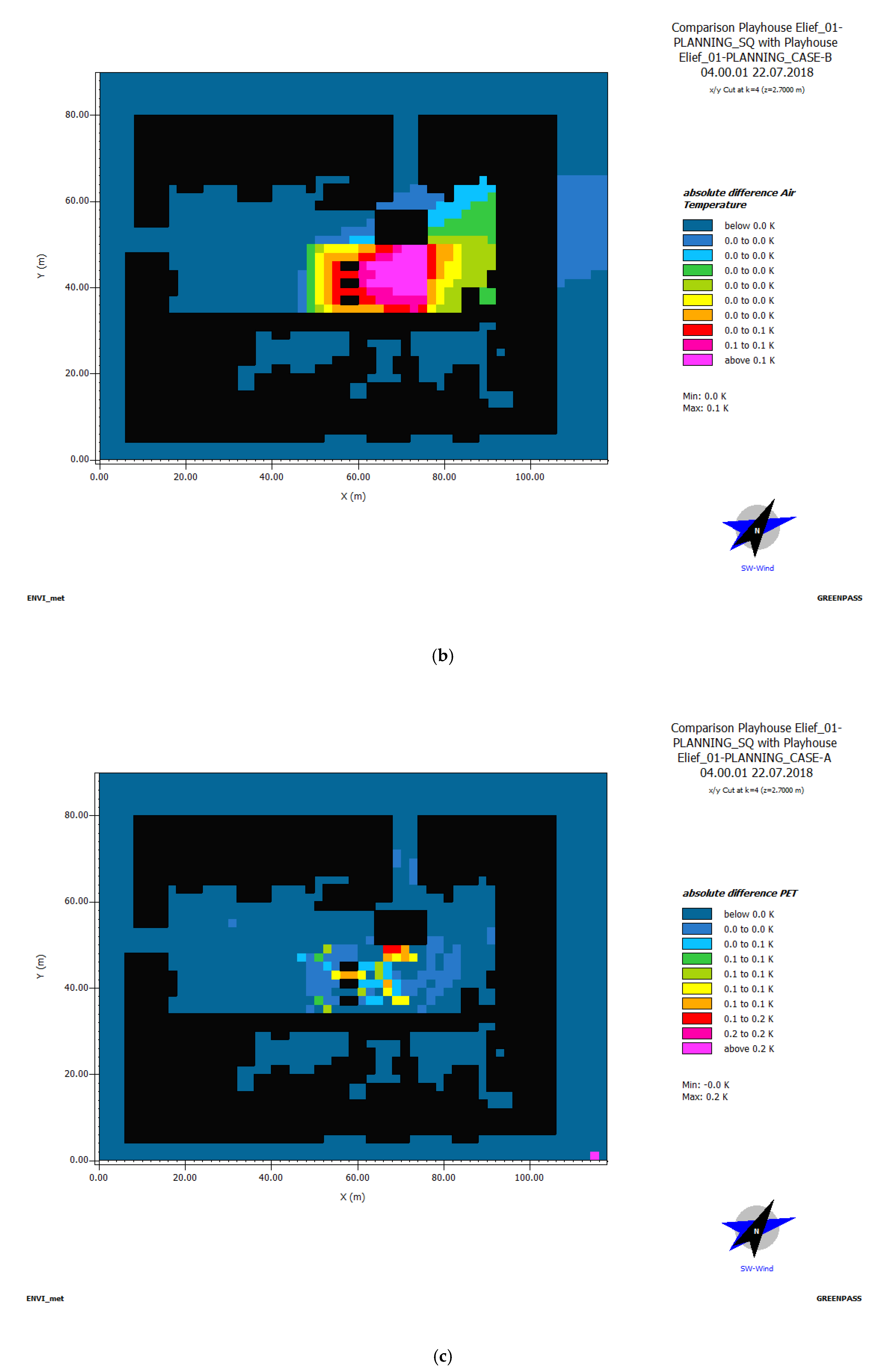
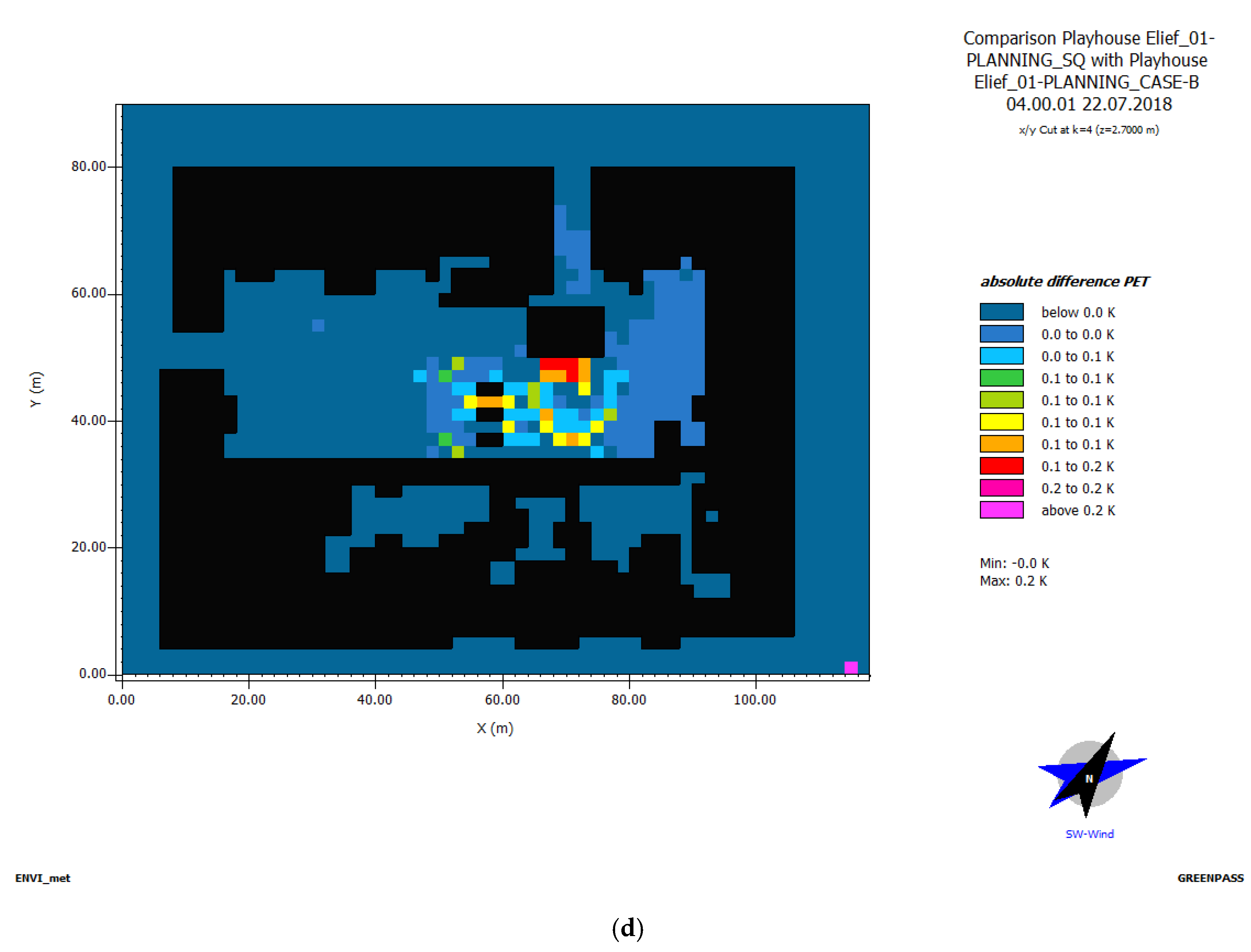
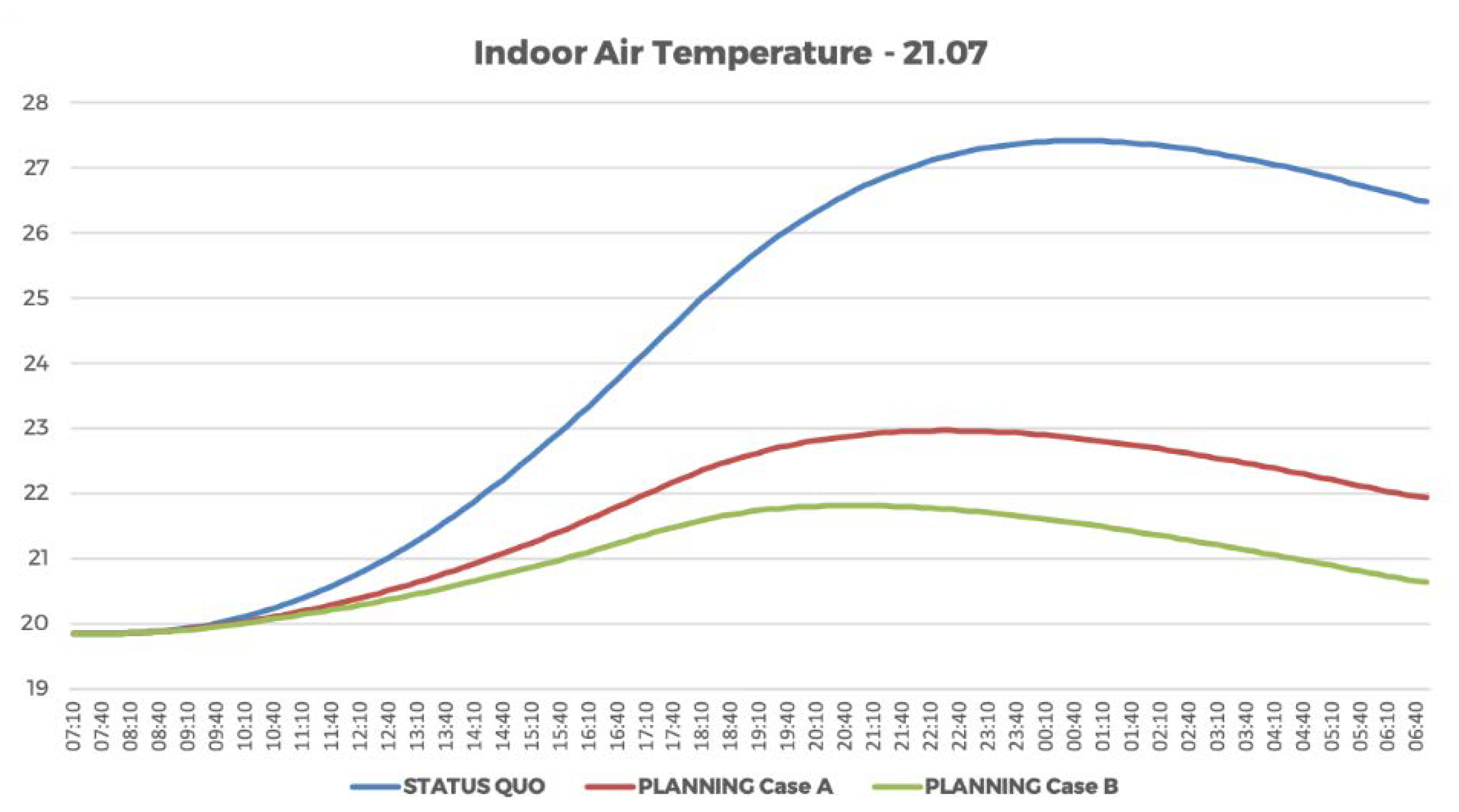
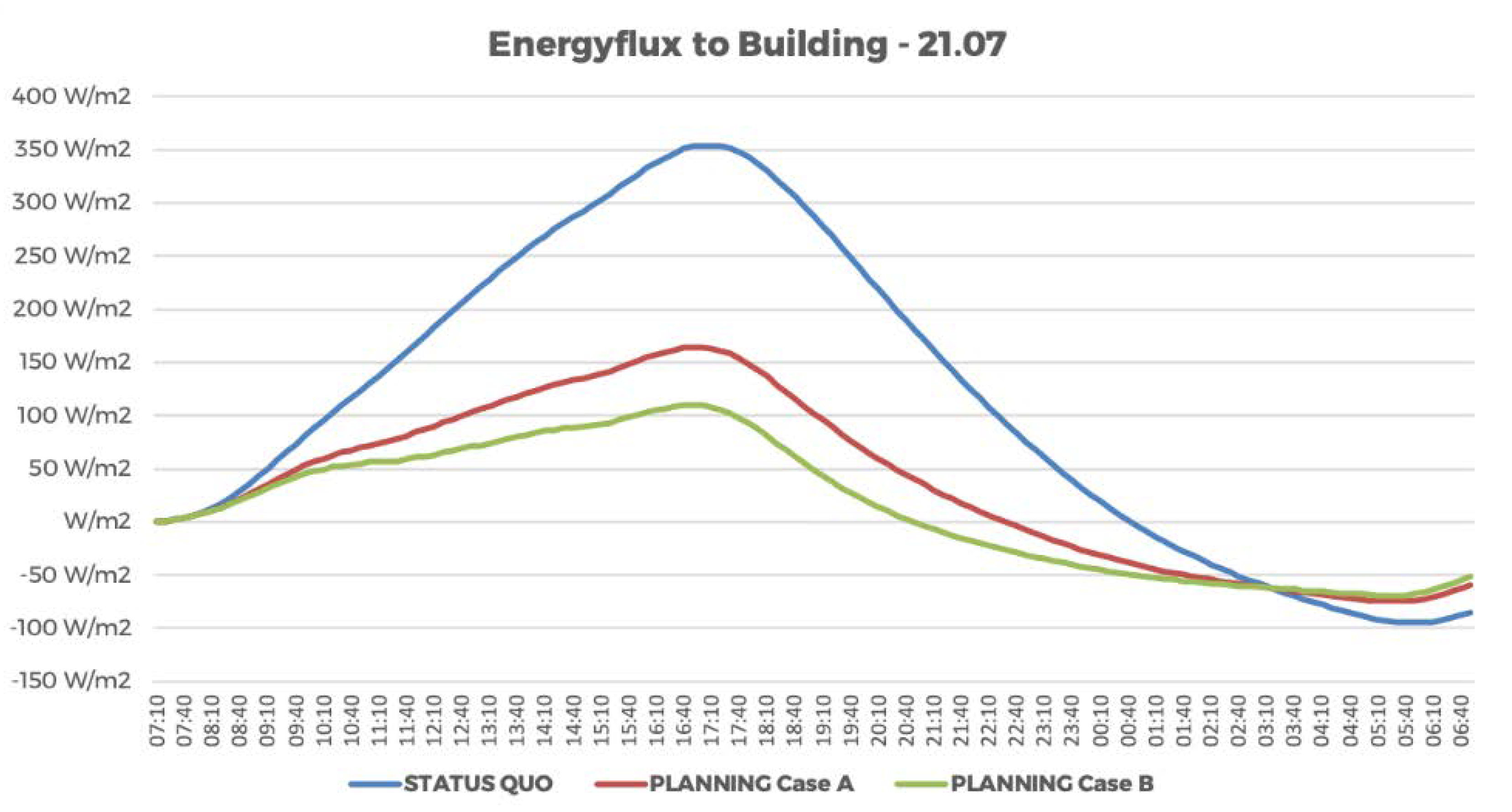
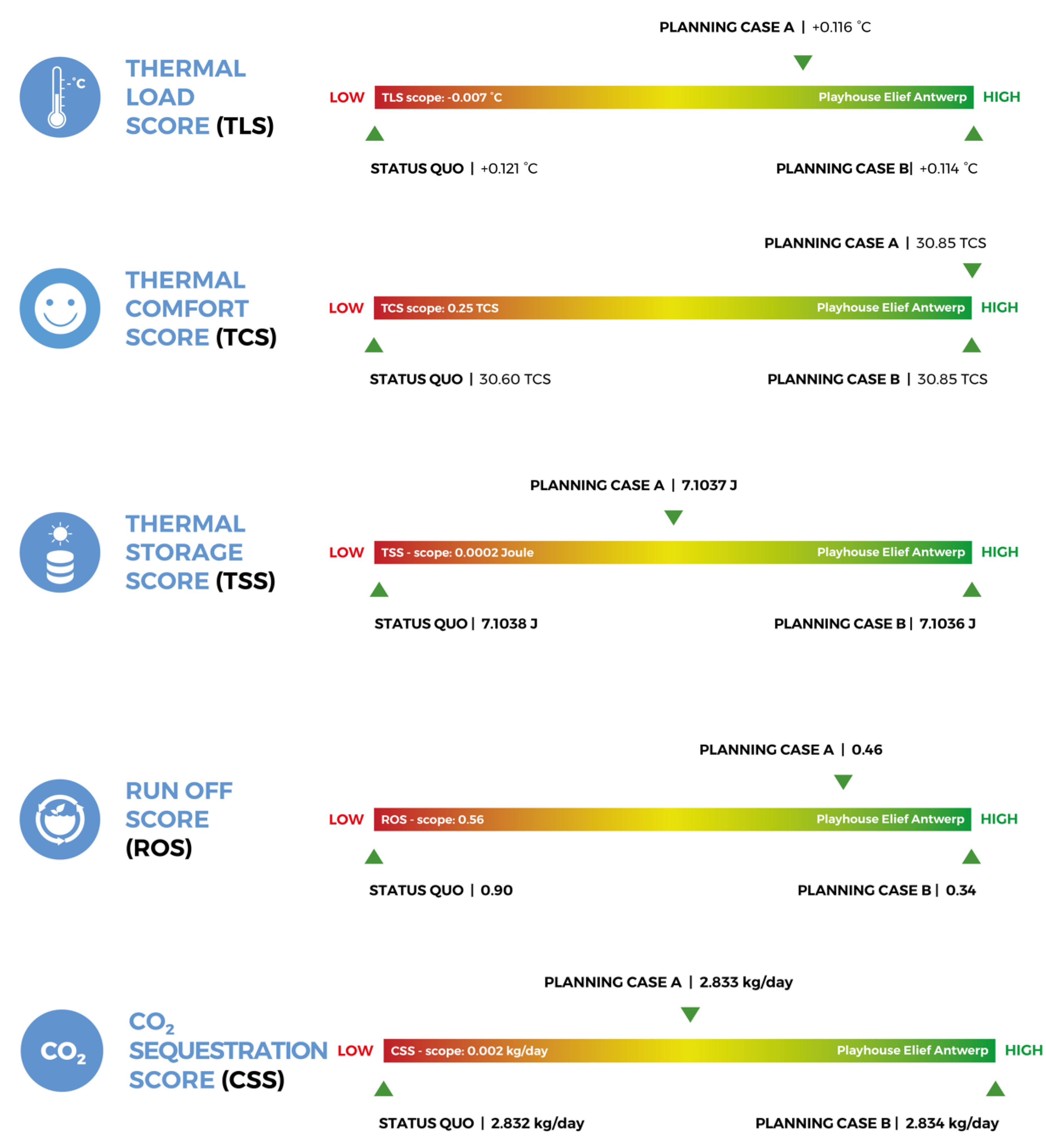
| Maximum Difference in °C, Compared to Status Quo | Variant A | Variant B |
|---|---|---|
| AT—Roof Level—15:00 | −0.6 | −0.7 |
| AT—Roof Level—04:00 | −0.1 | −0.1 |
| PET—Roof Level—15:00 | −0.6 | −0.7 |
| PET—Roof Level—04:00 | −0.2 | −0.2 |
| PET—Ground Level—15:00 | −0.2 | −0.3 |
| Parameter | Status Quo | Variant A | Variant B |
|---|---|---|---|
| Mean Indoor Air Temperature °C | 24.37 | 21.74 | 20.99 |
| Difference to Status Quo °C | 2.63 | 3.38 |
| Parameter | Status Quo | Variant A | Variant B |
|---|---|---|---|
| Energy flux of building W/m2 | 16,499 | 5156 | 1932 |
© 2019 by the authors. Licensee MDPI, Basel, Switzerland. This article is an open access article distributed under the terms and conditions of the Creative Commons Attribution (CC BY) license (http://creativecommons.org/licenses/by/4.0/).
Share and Cite
Scharf, B.; Kraus, F. Green Roofs and Greenpass. Buildings 2019, 9, 205. https://doi.org/10.3390/buildings9090205
Scharf B, Kraus F. Green Roofs and Greenpass. Buildings. 2019; 9(9):205. https://doi.org/10.3390/buildings9090205
Chicago/Turabian StyleScharf, Bernhard, and Florian Kraus. 2019. "Green Roofs and Greenpass" Buildings 9, no. 9: 205. https://doi.org/10.3390/buildings9090205
APA StyleScharf, B., & Kraus, F. (2019). Green Roofs and Greenpass. Buildings, 9(9), 205. https://doi.org/10.3390/buildings9090205




